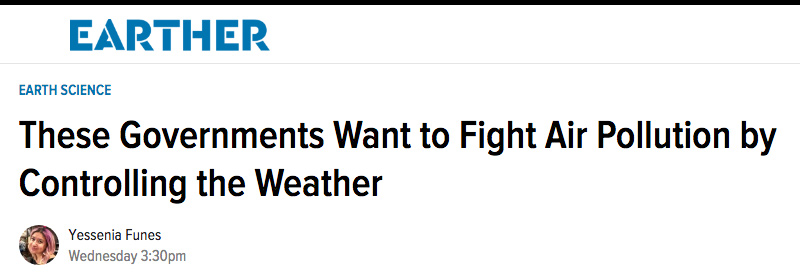APRIL 24, 2019

Editor’s Note: Hebrew U Professor Daniel Rosenfeld, who was interviewed for this story, recently received the 2018 Yoram J. Kaufman Outstanding Research and Unselfish Cooperation Award. Click here to read more.
PGlmcmFtZSBzcmM9Ii8vZWFydGhlci5naXptb2RvLmNvbS9lbWJlZC92aWRlby9pZnJhbWU/aWQ9bWNwLTM2NzE4MDUmcG9zdF9pZD0mYmxvZ19pZD0xNjM2MzkwMDE0JnBsYXRmb3JtPWVtYmVkJmF1dG9wbGF5PWZhbHNlJm11dGU9ZmFsc2UiIHdpZHRoPSI4MDAiIGhlaWdodD0iNDQ4IiBhbGxvd2Z1bGxzY3JlZW4gZnJhbWVib3JkZXI9MD48L2lmcmFtZT4=
Air pollution is taking over cities around the world. As the State of the Air report released Wednesday reminds us, nearly half of the people living in the U.S. deal with unhealthy air. In countries like South Korea and Thailand, however, that air pollution is on a whole other level.
That’s why these governments are turning to weather modification technologies in a bid to clean up the air. South Korea announced in March plans to begin deploying so-called cloud seeding technology to make it rain in Seoul, and the Thailand government actually went ahead and induced rain in Bangkok in January. But, um, how well does this actually work?
Cloud seeding, which basically involves misting clouds with small particles that help water droplets to form, isn’t exactly revolutionary. The idea has been around since the 1940s when Bernard Vonnegut, an atmospheric scientist, discovered that silver iodide particles could be used to form snow from water vapor in a lab. Since then, cloud seeding has been used to clear the skies for the Beijing Olympics in 2016 and to help mountaintops grow snowy in Colorado. But not every attempt to seed clouds is so successful.
“Cloud seeding presently is suffering from a lack of credibility not because it is not a credible thing to do, but because it is a hard thing to do correctly and should be done with rigorous science,” said Daniel Rosenfield, a professor of atmospheric sciences at the Hebrew University of Jerusalem’s Institute of Earth Sciences, to Earther.
Shooting clouds with an element like silver iodide can’t always produce rain, and the rain won’t always occur exactly how researchers would’ve liked. The conditions that exacerbate the air pollution in Southeast Asian countries—dry, cool air—don’t help when it comes to making clouds. So cloud seeding is often even more difficult to do successfully during these pollution events.
“The conditions when you need to clear the air pollution most are the least suitable for cloud seeding,” Rosenfield said.
And while cloud seeding can be a quick fix when poor air quality is putting life on pause, no amount of rain can stop the pollution at the source.
“It’s a very good idea to address the air pollution by reducing the emissions by moving to renewable energy, electrical cars,” Rosenfield told Earther. “That will solve not only the air pollution problem but the global warming problem.”